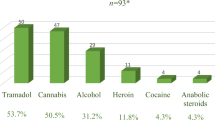Abstract
Introduction
The use of the new psychoactive substance 4-fluoroamphetamine (4-FA) and the number of 4-FA-related intoxications substantially increased in The Netherlands in recent years. We describe two patients with severe 4-FA-related complications and the characteristics of a large sample of 4-FA-intoxicated patients.
Methods
Information on patients with 4-FA-related intoxications between January 2009 and June 2017 was available from the Monitor Drug-related Incidents. Detailed clinical information was obtained of two patients with haemorrhagic stroke after toxicologically confirmed 4-FA use.
Results
We report on two patients who presented with headache and mild hypertension after 4-FA use. Patient A developed one-sided weakness and decreased consciousness after a few hours. A computed tomography scan showed a left-sided intracerebral haemorrhage. Because of life-threatening cerebral herniation, haematoma evacuation was performed. Postoperatively, she suffered from a right-sided hemiparalysis and severe aphasia, requiring clinical rehabilitation. Patient B had a subarachnoid haemorrhage without neurological deficits. In total, 939 4-FA-intoxicated patients were registered. These patients used 4-FA alone (44%) or in combination with alcohol (13%) and/or other drugs (43%).
Discussion
Patients using 4-FA are at risk for life-threatening health problems, including intracranial haemorrhage. Additional brain imaging should be considered in 4-FA-intoxicated patients, not only in the presence of neurological deficits, but also in the case of severe headache.

Similar content being viewed by others
References
Van der Gouwe D, Rigter S (2016) Annual report. Drugs information and monitoring system (DIMS). https://assets.trimbos.nl/docs/bb499f0e-177e-454d-888e-f22508e45f38.pdf. Accessed 20 Sept 2017
Monshouwer K, Van der Pol P, Drost YC, Van Laar MC (2016) The comprehensive 2016 nightlife study. https://assets.trimbos.nl/docs/da0f3e40-3ad6-498d-852c-9d59105a85c2.pdf. Accessed 20 Sept 2017
Linsen F, Koning RP, Van Laar M, Niesink RJ, Koeter MW, Brunt TM (2015) 4-Fluoroamphetamine in The Netherlands: more than a one-night stand. Addiction 110:1138–1143
Hondebrink L, Nugteren-van Lonkhuyzen JJ, Van Der Gouwe D, Brunt TM (2015) Monitoring new psychoactive substances (NPS) in The Netherlands: data from the drug market and the Poisons Information Centre. Drug Alcohol Depend 147:109–115
Wijers CHW, Van Litsenburg RTH, Hondebrink L, Niesink RJM, Croes EA (2017) Acute toxic effects related to 4-fluoroamphetamine. Lancet 389:600
Nugteren-van Lonkhuyzen JJ, Van Riel AJHP., Brunt TM, Hondebrink L (2015) Pharmacokinetics, pharmacodynamics and toxicology of new psychoactive substances (NPS): 2C-B, 4-fluoroamphetamine and benzofurans. Drug Alcohol Depend 157:18–27
Nagai F, Nonaka R, Satoh Hisashi Kamimura K (2007) The effects of non-medically used psychoactive drugs on monoamine neurotransmission in rat brain. Eur J Pharmacol 559:132–137
Baumann MH, Clark RD, Woolverton WL, Wee S, Blough BE, Rothman RB (2011) In vivo effects of amphetamine analogs reveal evidence for serotonergic inhibition of mesolimbicdopamine transmission in the rat. J Pharmacol Exp Ther 337:218–225
Al-Abri S, Meier KH, Colby JM, Smollin CG, Benowitz NL (2014) Cardiogenic shock after use of fluoroamphetamine confirmed with serum and urine levels. Clin Toxicol (Phila) 52:1292–1295
Wolf CE, Poklis JL, Cumpston K, Moss M, Poklis A (2017) Acute dilated cardiomyopathy and myocardial injury after combined 4-fluoroamphetamine and modafinil ingestion. Drug Test Anal 9:657–659
Laskowski LK, Landry A, Vassallo SU, Hoffman RS (2015) Ice water submersion for rapid cooling in severe drug-induced hyperthermia. Clin Toxicol (Phila) 53:181–184
Knippels MCJ, Essers IMM, Magdelijns FJH, Van Twist DJL (2017) Ecstasy-light’—not as light as its name suggests: toxic effects of 4-fluoroamphetamine. Ned Tijdschr Geneeskd 16:D1356
Hondebrink L, Nugteren-van Lonkhuyzen JJ, Rietjens SJ et al (2017) Fatalities, cerebral hemorrhage, and severe cardiovascular toxicity after exposure to the new psychoactive substance 4-fluoroamphetamine: a prospective cohort study. Ann Emerg Med. https://doi.org/10.1016/j.annemergmed.2017.07.482
Wijers L, Croes E, Valkenberg H (2016) Monitor drug-related Incidents Factsheet 2016. https://assets.trimbos.nl/docs/d9683b48-d544-457e-9fc7-903c3bfd92d8.pdf. Accessed 01 Oct 2018
Yeung M, Bhalla A, Birns J (2011) Recreational drug misuse and stroke. Curr Drug Abuse Rev 4:286–291
Fonseca AC, Ferro JM (2013) Drug abuse and stroke. Curr Neurol Neurosci Rep 13:325
Ducros A (2012) Reversible cerebral vasoconstriction syndrome. Lancet Neurol 11:906–917
Cappelen-Smith C, Calic Z, Cordato D (2017) Reversible cerebral vasoconstriction syndrome: recognition and treatment. Curr Treat Options Neurol 19:21
Acknowledgements
We are grateful to the patients for giving their consent. We also thank E. J. P. Franssen, Head of the Department of Clinical Pharmacy, Onze Lieve Vrouwe Gasthuis, Amsterdam, The Netherlands, for analysing the urine samples of the patients. The Monitor Drug-related Incidents is financially supported by the Dutch Ministry of Health, Welfare, and Sport.
Author information
Authors and Affiliations
Corresponding author
Ethics declarations
Ethical standards
The local ethics committee confirmed that analyses of the anonymous data from the MDI database do not require separate ethics approval. Written informed consent was received from both presented patients. The study has been performed in accordance with the ethical standards laid down in the 1964 Declaration of Helsinki and its later amendments.
Conflicts of interest
The authors declare that they have no conflict of interest.
Rights and permissions
About this article
Cite this article
Wijers, C.H.W., Visser, M.C., van Litsenburg, R.T.H. et al. Haemorrhagic stroke related to the use of 4-fluoroamphetamine. J Neurol 265, 1607–1611 (2018). https://doi.org/10.1007/s00415-018-8888-6
Received:
Revised:
Accepted:
Published:
Issue Date:
DOI: https://doi.org/10.1007/s00415-018-8888-6




